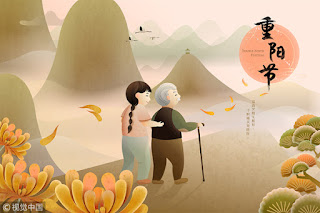A girl climbs a mountain with her grandma to enjoy the chrysanthemums during the Double Ninth Festival. [Photo/VCG]
The ninth day of the ninth month in the Chinese lunar calendar is a traditional Chinese festival — the Double Ninth Festival, or Chongyang Festival. In Chinese culture, nine has long been regarded as the number of yang, making the day of the festival one of two yang numbers, while "chong" in Chinese means double - thus creating the name of the festival, Chongyang.
A traditional poem written by Wang Wei during the Tang Dynasty is often quoted in relation to the holiday, which reads:
“As a lonely stranger in a foreign land,I pine at every holiday - my homesickness increases.Far away, I know my brothers have reached the mountain peak;They are wearing dogwood, but one is not present.”
Traditional customs of the festival include reaching a mountain peak and wearing dogwood just as in the poem, though many young people don't even know what dogwood looks like. What does the Double Ninth Festival mean today? Why do people climb mountains and wear dogwood on this special day? Why is the festival celebrated as "Senior Citizens Day" now?
read more
Some of the oldest Chinese temples in Singapore, Built in the early tumultuous years
Clockwise from top left: Ying Fo Fui Kun temple, Lian Shan Shuan Lin Monastery, Thian Hock Keng temple and Fuk Tak Chi temple
The Fuk Tak Chi temple, for example, was built in the 1820s by a group of Cantonese and Hakka-speaking Chinese settlers in the middle of what is now Singapore’s business district. The temple’s signature architectural style, which includes floral roof motifs, is reminiscent of temples in Fujian, China, and stands out among the row of shophouses along Telok Ayer Street near Chinatown. Taken together, the city’s tapestry of Chinese temples are easily mistaken for a mismatched and motley collection of competing styles. But look deeper and find they speak to the identities of those who made Singapore home, bringing their architecture and preferences with them to be shaped by a common community sometimes at odds with itself. We talked to a temple guru about their history, why they differ architecturally, how they came to be, and where to find them today.
Beyond being places of worship, these elaborately decorated monuments are also places for people to socialize within the different Chinese groups and clans. Singapore is predominantly made up of Chinese, whose predecessors came from families that spoke different dialects, with Hokkien being the most common, followed by Teochew, Cantonese, Hakka, and many others. Different dialects have different tones and pitches, with Mandarin having four tone levels, while Hokkien and Teochew have eight, Hakka six, and Cantonese nine.

